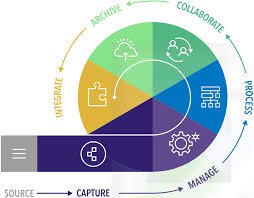Executive Summary
In today’s knowledge economy, the volume, velocity, and variety of enterprise content have reached unprecedented levels. Organizations face an urgent imperative to manage this content not merely as a by-product of business operations, but as a critical asset. Enterprise Content Management (ECM) is emerging as a cornerstone of digital transformation—delivering measurable value across operational efficiency, regulatory compliance, and customer engagement.
This insight explores how forward-thinking enterprises are leveraging ECM solutions to unlock business value, streamline processes, and future-proof their content strategy.
Why ECM Now: A Strategic Lens
- Information Overload and Disconnected Systems
As data volumes surge, fragmented content repositories hinder productivity and increase compliance risk. ECM centralizes content, creating a single source of truth across the enterprise. - Remote and Hybrid Workforces
The shift toward decentralized work environments has elevated the need for secure, cloud-based content platforms. ECM provides access agility while safeguarding sensitive data. - Rising Compliance Pressures
Regulatory frameworks such as GDPR, HIPAA, and SOX demand robust governance. ECM platforms ensure audit-readiness and enforce retention policies automatically. - Process Automation and Cost Reduction
By digitizing and automating document-intensive workflows (e.g., procurement, HR onboarding, claims processing), ECM enables faster decision cycles and reduces operational overhead.
Business Benefits of ECM
| Strategic Driver | Business Impact |
| Operational Efficiency | Automated workflows reduce processing time and manual errors. |
| Risk Mitigation | Access controls, versioning, and audit trails ensure content integrity and regulatory compliance. |
| Customer Experience | Faster information retrieval improves responsiveness and service quality. |
| Data-Driven Decisions | Centralized content enhances analytics, insights, and enterprise intelligence. |
Market Landscape: Evaluating Leading ECM Platforms
Leading ECM vendors are redefining content management through AI, cloud scalability, and integration ecosystems:
- Microsoft SharePoint – A robust collaboration and content hub, especially for Microsoft-centric enterprises.
- IBM FileNet – Ideal for compliance-heavy industries requiring enterprise-grade governance.
- OpenText – A broad digital experience suite supporting advanced content workflows.
- Hyland OnBase – Noted for rapid deployment and cross-functional application.
- M-Files – Pioneers metadata-driven content management for intelligent document handling.
Strategic ECM selection must align with your organization’s digital maturity, regulatory environment, and scalability goals.
Case Example: ECM Driving Operational Agility
A global financial services firm implemented IBM FileNet to consolidate legacy content repositories across regional offices. Result:
- Reduced document retrieval time by 70%
- Automated regulatory reporting for 15+ jurisdictions
- Achieved $1.2M annual savings through digitization and workflow streamlining
Such cases demonstrate ECM’s role not just as a technology investment, but as a transformation catalyst.
Key Considerations for Enterprise Leaders
- Governance First: Prioritize frameworks that manage content lifecycles, not just storage.
- Cloud-Native vs. On-Premise: Evaluate security, scalability, and cost trade-offs.
- User Adoption: Invest in change management to embed ECM into daily workflows.
- AI Integration: Seek platforms offering intelligent classification, automated tagging, and predictive search.
Final Thought: From Storage to Strategy
ECM is no longer a tactical document repository—it is a strategic enabler of enterprise resilience and growth. In a world where information is power, how you manage content can determine how fast you innovate, how well you serve, and how securely you scale.
Forward-looking enterprises are not just adopting ECM—they are embedding it into the fabric of their digital operating model.

